How to Become a Full-time Trader? 11 Important Steps to Follow
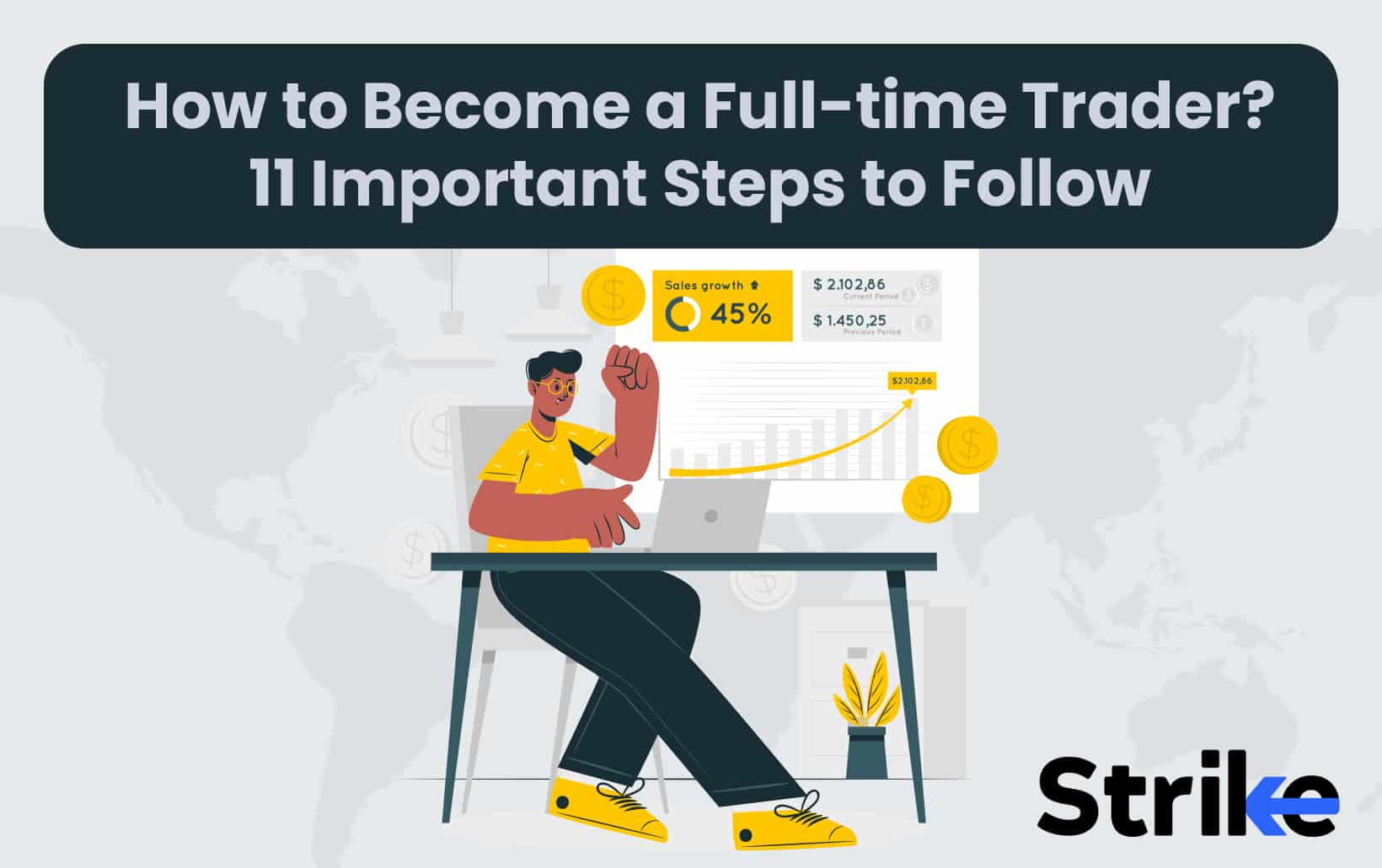
A full-time trader is someone who spends a significant amount of time trading, four to eight hours per day on average, during the market season to generate wealth over the long term. A full time trader’s time spent on the market includes not just hitting the buy or sell button, but also monitoring, researching, and planning the trade.
Becoming a full-time trader is a coveted goal for many investors, attracted by the flexibility and profit potential that this trade offers. Becoming a full-time trader requires specific skills and careful preparation.
It is essential to honestly evaluate your market knowledge through your trading history over 6 to 12 months. Identifying its shortcomings helps to fill its weaknesses through ongoing training, with experienced mentors and within trader communities.
Developing a robust and personal trading strategy with clear entry and exit rules is also essential. It is recommended to test it intensively through paper trading and backtests over several years and market environments.
Mastering risk management is crucial to long-term survival. Diversification, suitable position size, loss stops, and leverage limitation are some of the indispensable techniques.
Limited starting capital, detailed trading journal, timeframe choice, instruments, and tools: each step counts to prepare your smooth transition to the full-time trader business.
Patient and humble in the face of failures, persistent in the continuous improvement of their strategy, the most successful traders manage to generate stable profits. With discipline and passion for financial markets, this exciting profession can become a thriving career.
1. Evaluate Your Knowledge
The first critical step is an honest evaluation of your current skills and experience in trading. Take time to thoroughly analyze your understanding across all aspects of the financial markets, not just stocks.
Develop a deep comprehension of how asset prices are impacted by economic data like GDP, inflation, interest rates, and employment numbers. Keep up with geopolitical events across the globe and understand how government policy, elections, wars, and other factors can influence market psychology. Make an effort to learn about commodities, currencies, real estate, and other alternative assets. The wider your knowledge base, the greater the potential edge you have in trading opportunities.
Review your personal trading track record in detail over at least the past 6-12 months. Carefully examine metrics like your win rate, risk-reward ratio, percent profitable trades, number of consecutive winners or losers, days at a loss, drawdowns, sharpe ratio, and sortino ratio. Win rate refers to the percentage of trades that are winners. Risk-reward ratio quantifies how much you profit on winners versus how much you lose on losing trades. Percent profitable tells how many trades ultimately generate gains.
Analyzing these statistics over an extended period identifies strengths and weaknesses in your trading approach. For example, a low win rate under 50% indicates a lack of edge in selecting profitable trades. A risk-reward ratio under 1:1 suggests poor trade management and cutting winners too early while letting losers run. Drawdowns over 10-20% may signal undisciplined risk management. Low sharpe and sortino ratios show excessive volatility and underperformance compared to a risk-free benchmark.
The goal of review is to pinpoint gaps like having no defined strategy, improper risk management, inadequate capital, or simply lacking experience. Be honest about knowledge deficiencies that need work. Common gaps include the below.
- No consistent strategy with clear rules
- Improper position sizing and risk management
- Overtrading and lack of patience
- Inability to read charts properly or identify trading signals
- Minimal screening or analysis of trades
- Failure to track trading statistics
- Reacting emotionally rather than sticking to plans
Once gaps are identified, research and study strategies of professional traders extensively to gain insights into “What is Stock Market.” Learn new techniques by reading books about “What is Stock Market,” taking courses, and studying training materials. Join online or local trading communities to discuss ideas with like-minded individuals. Seek out a mentor with a verifiable track record of success to provide guidance and feedback.
2. Start Learning
Starting to learn deeply about the stock market is extremely important for any aspiring trader or investor. There are concepts, strategies, and analyses to build a strong foundation before putting real capital at risk in the markets.
One of the best ways to start is by reading stock market books that provide an introductory overview of investing approaches. Some classics that should be on any beginner’s reading list include the below.
| Book Title | Author | Investment Approach |
| The Intelligent Investor | Benjamin Graham | Value Investing |
| A Random Walk Down Wall Street | Burton Malkiel | Passive Investing |
| The Little Book of Common Sense Investing | John Bogle | Index Funds |
| One Up on Wall Street | Peter Lynch | Stock Picking |
| The Essays of Warren Buffet | Warren Buffett | Value Investing |
Beyond these foundational books, taking online courses can further enhance knowledge of investing essentials. Courses are available on platforms like Udemy, Coursera, and EdX covering topics such as those below.
| Course Title | Description | Target Audience |
| The Complete Stock Market Trading Course for Beginners (India) | Covers basics of stock market investing in India, including fundamental and technical analysis, chart patterns, and risk management. | Beginners with no prior knowledge |
| Technical Analysis Masterclass – Charting, Patterns & Trading Strategies (For Indian Markets) | Dives deep into technical analysis, teaching how to use charts, indicators, and patterns to identify trading opportunities. | Beginners with some understanding of technical analysis |
| Options Trading Strategies for Indian Stock Market | Explains options contracts, option strategies (calls, puts, spreads), and their use for income generation or hedging. | Basic understanding of stock markets and some risk tolerance |
| Value Investing in Indian Stock Market | Explores value investing principles like margin of safety and company analysis to identify undervalued stocks. | Beginners interested in long-term investing strategies |
| Swing Trading Strategies for Indian Stock Markets | Focuses on swing trading strategies, identifying short- to medium-term trading opportunities. | Some understanding of technical analysis and risk management |
| Day Trading for Beginners (Indian Stock Market) | Introduces day trading concepts, order types, and risk management for active traders. | Solid understanding of technical analysis, risk tolerance, and ability to handle fast-paced markets |
| Algorithmic Trading with Python (For Indian Markets) | Teaches how to build automated trading strategies using Python programming. | Programming experience and some understanding of technical analysis |
| Fundamental Analysis for Stock Selection (Indian Companies) | Deep dives into company financials, valuation techniques, and identifying strong investment candidates. | Interest in long-term investing and understanding company analysis |
| Mastering Technical Indicators for Profitable Trading (India) | Explores various technical indicators and their application in identifying trading signals. | Working knowledge of technical analysis and chart patterns |
| Building a High-Performance Trading Psychology (For Indian Markets) | Emphasizes the importance of mindset and emotional control in successful trading. | Investors/Traders of all levels looking to improve their trading psychology |
Study key ratios like the price-to-earnings, debt-to-equity, profit margins, return on equity, and current ratios, as they are fundamental to analyzing a company’s financial health. Calculate these fundamental ratios by hand from financial statements to truly understand their construction. Use them to compare companies in the same industry.
Spend time on paper trading to simulate trades without risking real capital, as it is a crucial step in understanding “How to learn stock market.” Experiment with stop losses, position sizing, risk management, and executing different strategies to master “How to learn stock market” effectively. Paper trading provides invaluable experience before going live.
3. Develop a Trading Strategy
Developing a strategy is important to becoming a full time trader as it helps you have a clear idea on how to trade. Consider what markets you want to trade, your capital, and tools for identifying opportunities. Strategies range from fundamental analysis to quantitative and algorithmic trading. Let us look at three of the most common trading strategies.
EOD strategy: EOD is a trading strategy that involves making trading decisions based on the price action and technical indicators from the previous trading day. EOD traders typically place orders before the market opens the following day or after the market closes the same day.
This strategy necessitates the analysis of price action in relation to the previous day’s price movements. End-of-day traders can then speculate on how the price will move based on the price action and decide which indicators to use in their system. Look at the below chart.
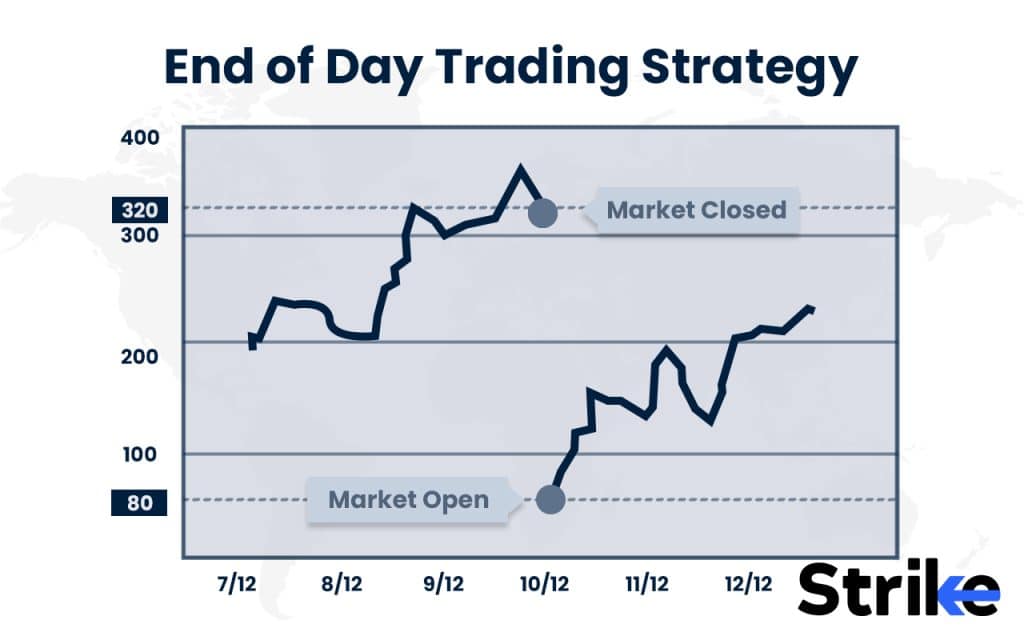
The blue line represents the price movements of an asset or security. Market is open, indicated by the label “Market open,” The price fluctuates within a relatively narrow range around 80. However, once the market closes, indicated by the label “Market closed,” the price exhibits a significant upward movement, reaching a peak of around 340 before declining again as the market reopens.
This pattern suggests that the end-of-day trading strategy involves analyzing the price action and indicators from the previous trading day and then placing trades either before the market opens or after it closes.
- Swing trading strategy
Swing trading is a method of investing in stocks that allows you to profit over a period of several days or weeks. Swing traders do this by analyzing stock price patterns, attempting to predict when the price will rise so they can buy low and fall so they can sell high. This entails looking at charts and analyzing previous price movements.
Stocks are chosen by considering short-term market trends, conducting technical analysis, and identifying potential quick profit opportunities. Portfolio Composition involves selecting a limited number of highly volatile stocks or other assets with the aim of generating quick profits. Look at the below chart.
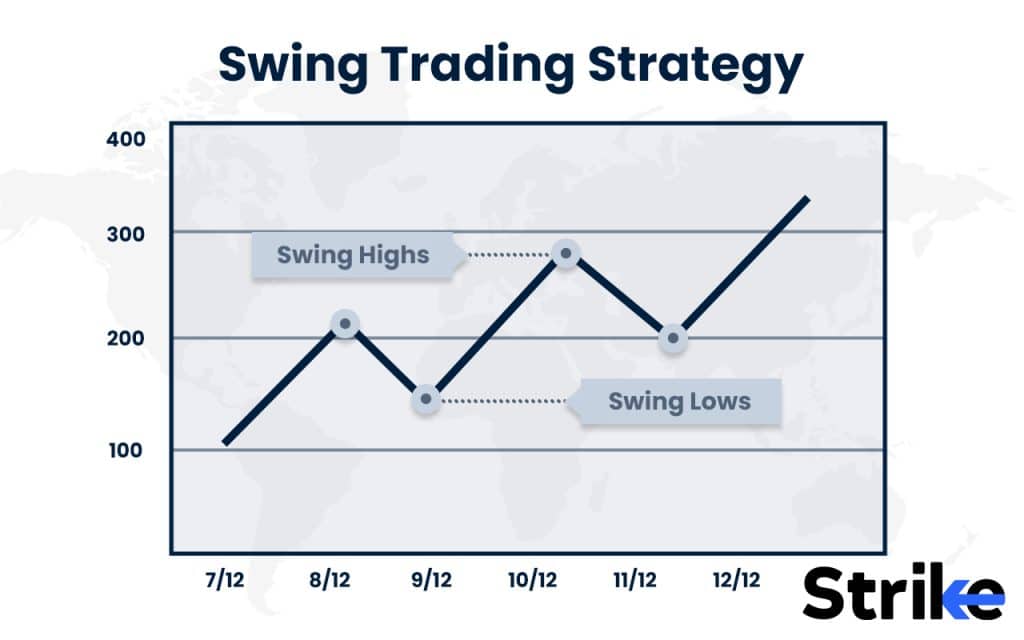
Swing highs are marked where the price reaches a peak before reversing direction downwards. These are potential points to sell or initiate a short position.
Swing lows are marked where the price reaches a trough before reversing direction upwards. These are potential points to buy or initiate a long position.
- Intraday trading
Intraday trading, also known as day trading, is the buying and selling of stocks on the same day. The stock market is subject to fluctuations, which cause stock prices to vary throughout the day, which aids intraday trading.
Day trading is appropriate for traders who want to actively trade during the day, typically as a full-time profession. Day traders take advantage of price fluctuations between the market’s open and close times. Day traders frequently hold multiple positions open throughout the day, but do not leave positions open overnight to reduce the risk of overnight market volatility.
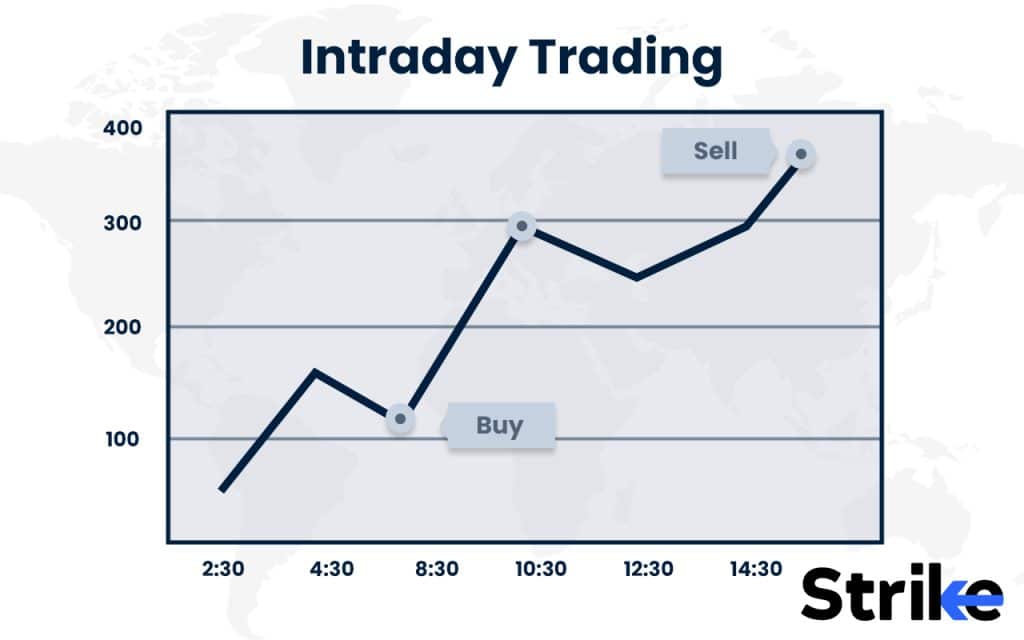
In the chart, “Buy” point indicates a potential entry or buy signal for a long position, as the price appears to have reached a low point and starts to rise.
“Sell” point suggests an optimal exit or sell signal for the long position, as the price has risen substantially from the buy point, allowing the trader to capture gains.
Define entry and exit rules, position sizing, stop losses, and target profits. Backtest your strategy over various market environments to evaluate its efficacy. Continually review and refine as you gain experience. An edge comes from discipline in executing your strategy, not complexity. Stay within your comfort zone. Start with a simple strategy that fits your personality.
4. Impliment Risk Management
Key risk management techniques include position sizing, diversification, using stop losses, and limiting leverage.
- Position size based on a percentage of your account balance rather than fixed quantity. This ensures no single trade or series of losses wipes out your account.
- Diversify across asset classes, sectors, and time frames. Don’t put all your eggs in one basket. Use stop losses on every trade to limit downside.
- Determine stop levels based on chart support/resistance or percentage loss you’re willing to accept.
- Trailing stops can lock in profits as the market moves in your favor. Manage leverage appropriately for your strategy and risk tolerance.
- Higher leverage magnifies gains but also increases risk of margin calls and forced liquidations in choppy markets. Maintain a detailed trading journal to analyze losses and improve.
Let profits run but cut losses quickly. Follow wise risk reward ratios like 1:2 or more. Stay disciplined in sticking to your plan, as effective risk management is crucial. Patience and minimizing mistakes are key to longevity, and good risk management helps ensure you stay on track.
5. Paper Trade, Simulate, and Backtest
It’s essential to practice and test your strategy through paper trading, simulation, and backtesting.
Paper trading involves tracking hypothetical trades in a journal or using a broker’s paper trading platform. Simulate trades using historical data in a spreadsheet or software. Backtest over many years and market environments. This allows you to evaluate the viability and profitability of your strategy before committing capital. Below are five popular paper trending platforms in India.
1) Trading View
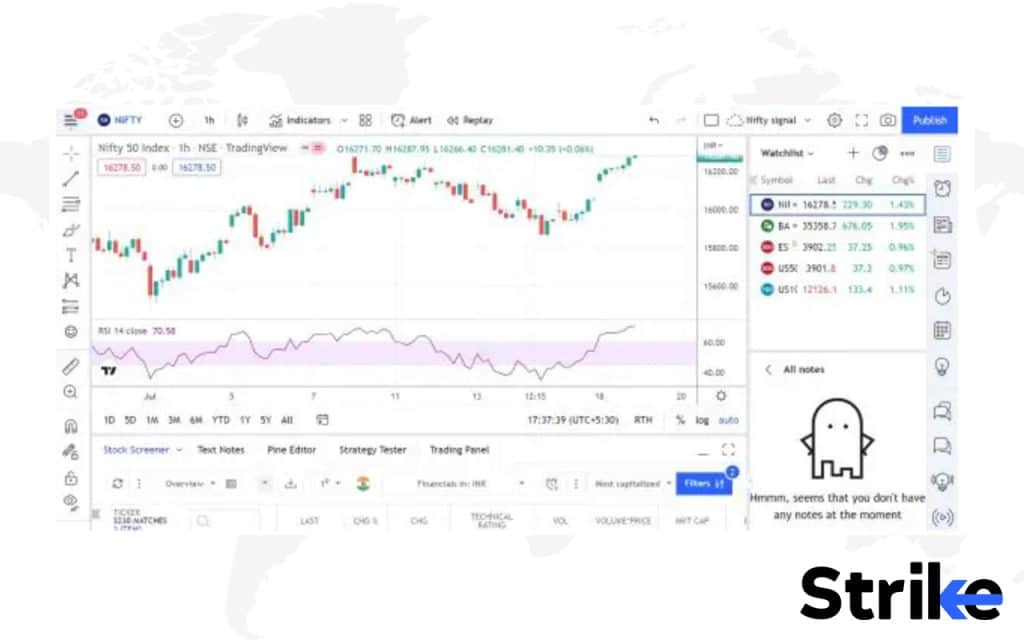
2) Sensibull
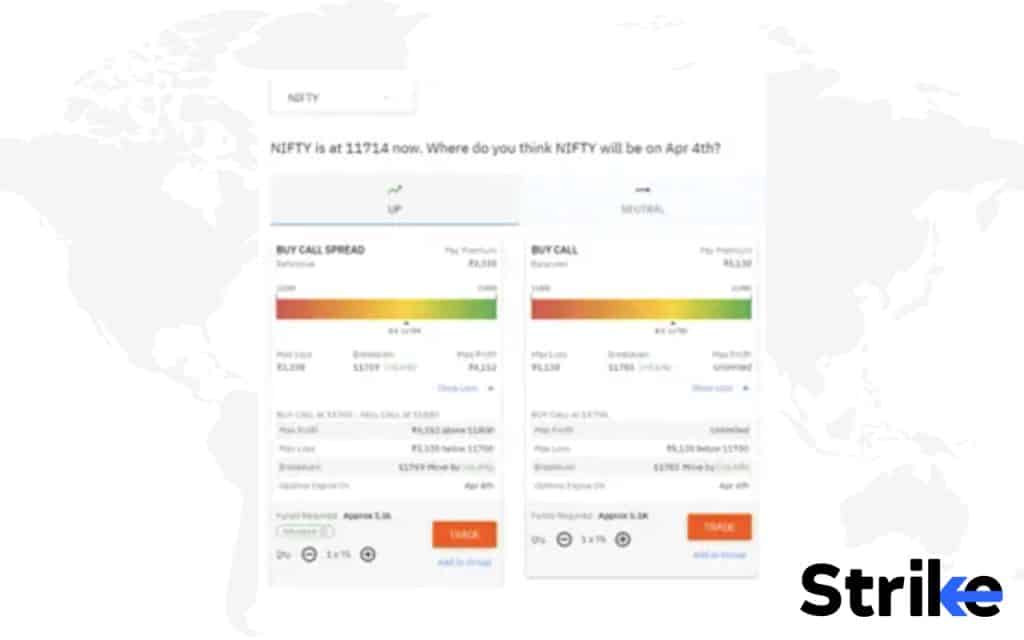
3) Zerodha

- Dalal Street Investment Journal (DSIJ) paper trading
- front.page
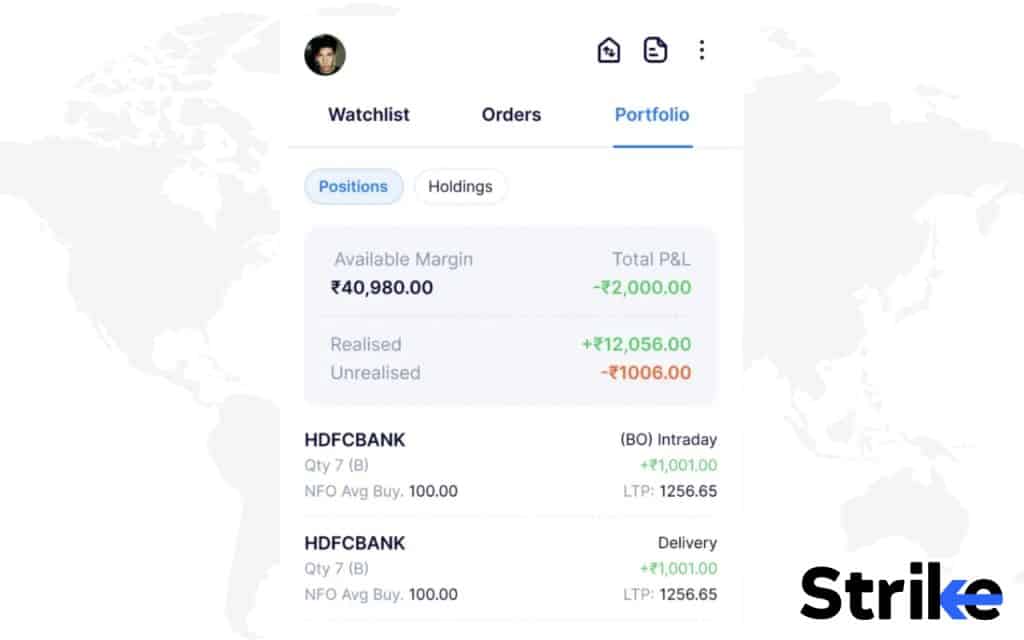
You can tweak inputs and refine rules that don’t work well. Paper trading and simulation build experience without financial risk. Monitor and review your hypothetical trades as if they were real. This process uncovers flaws in your plan, psychology, or execution. Backtesting investment strategy builds discipline by forcing you to follow a system. By consistently backtesting investment strategy, you can refine your approach and improve your decision-making process.
6. Learn Types of Trading Tools to Use
Trading tools are the arsenal of your strategy. It is important to choose the right trading tool. Below are five trading tools you could consider.
Strike

Strike is an innovative stock market analysis tool designed specifically for traders in India. With Strike, you get an all-in-one solution to supercharge your stock trading through advanced analytics and real-time insights. The key feature of Strike is its proprietary scanners and indicators. These are customized tools that filter the stock market efficiently to highlight the best trading opportunities. The scanners automatically analyze charts to identify trend patterns, candlestick formations, and potential breakouts. This provides an edge in making timely trading decisions.
In addition, Strike offers robust functionality for futures and options traders. Predefined strategies are available to optimize trading performance. Strike also enables creating customized dashboards to display the most relevant data, charts, and trends for your specific trading approach. Staying updated with market news and expert analyst commentary is also seamlessly integrated. Strike sources actionable insights from leading financial analysts so you will be able to make well-informed investment decisions.
Zerodha Kite
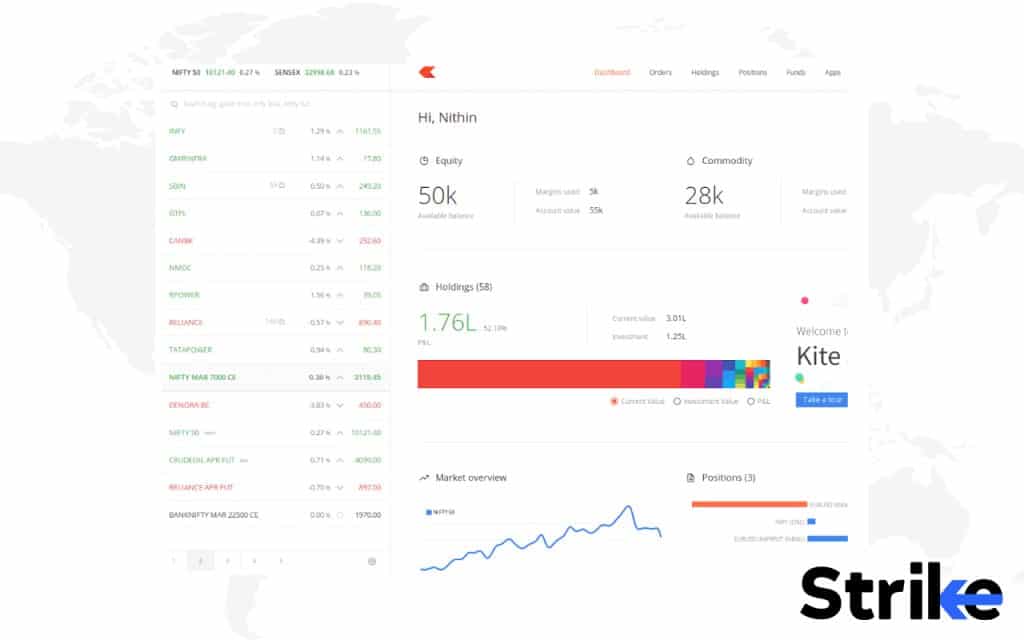
Kite by Zerodha is one of the most popular stock trading platforms in India. It offers a fast, reliable, and easy to use interface. Features include charts, alerts, research reports, margin details, and more. Zerodha also provides APIs for algorithmic trading.
TradingView
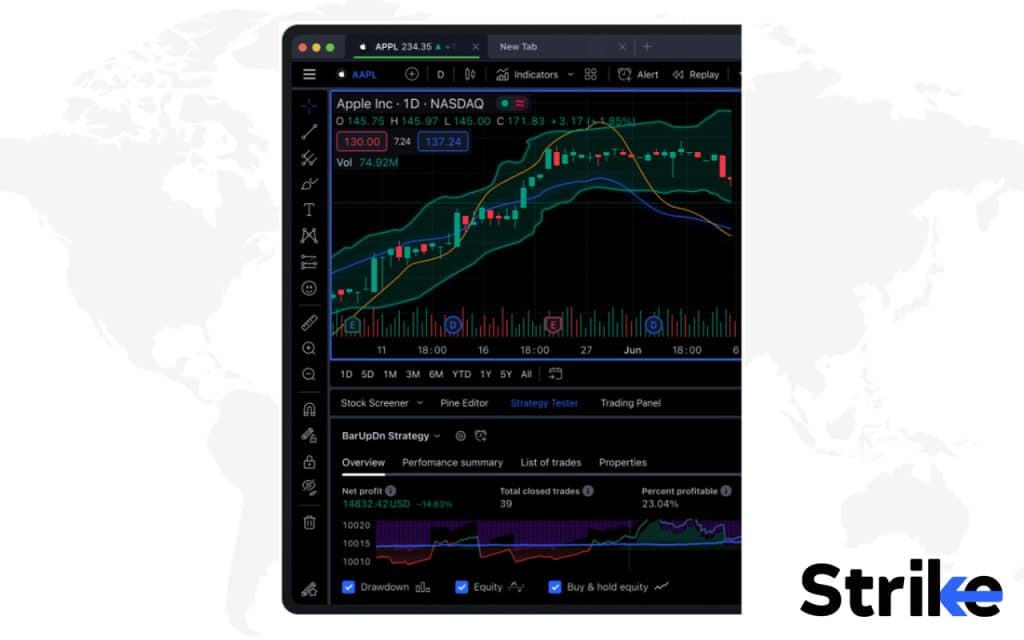
This is an excellent charting and analysis platform with a huge community. Use advanced charts, indicators, scripts, and drawing tools for technical analysis. Access real-time data feeds. Available as web and mobile apps. Integrates with many brokers.
Economic Times Markets

Stay updated with latest stock market news, data, analysis and opinion from The Economic Times, one of the top business and financial publications in India. Access on their website or mobile app.
Screener.in

This is a leading stock screening and analysis platform for Indian markets. Use prebuilt or custom screens to filter stocks based on fundamentals, valuation, technicals, trends and more. Available on web and mobile.
Ensure you choose a tool that is user-friendly and intuitive. For example, Strike. An intuitive, user-friendly interface allows easy navigation and interaction with all of Strike’s powerful features.
7. Start with Small Trading Capital
It’s wise to start with a small amount of capital. Trading with real money is an essential step, but limit your initial risk. Deposit an amount you are comfortable losing as you gain experience. Starting too big can be disastrous for new traders when inevitable losses occur. Begin with a few thousand rupees, depending on your financial situation. This allows you to practice real trades without high dollar risks. Take your time building skills using small positions. As you become consistently profitable with your strategy, trading capital can be increased gradually. Never add to losing positions in an effort to recoup losses quickly. This only compounds risk.
Master solid risk management and emotions by trading small first. Portfolio management skills are crucial at this stage. Then, you can scale up prudently as account size permits, keeping portfolio management in focus. Patience and discipline are key.
8. Update Trading Journal
Maintaining a detailed trading journal is crucial to analyze both wins and losses in order to improve. Log every trade with entries including date, stock name, quantity, entry price, exit price, stop loss, and reasoning. Record your emotional state at the time of trading. Review trades to identify mistakes and determine if your strategy was followed.
Seek to understand losses and avoid repeating errors. Reflect on wins as well. Over time, journals reveal insights about strengths and weaknesses.
Always be reviewing and refining rules that aren’t working. The journaling process builds discipline and accountability. It tracks progress in executing trading plans. Updating logs makes you a better trader.
9. Choose a Timeframe
It’s important to select an appropriate timeframe that matches your style and goals. Five common intraday timeframes are listed below.
Scalping
Scalping is the shortest timeframe in the trading world, where positions are held for mere minutes or even seconds. Scalpers often utilize 1-minute, 5-minute, or 10-minute charts to identify and capitalize on small price movements. This style of trading requires lightning-fast reflexes, unwavering focus, and a keen eye for market patterns. Scalpers aim to capture numerous small profits throughout the trading day, which can quickly accumulate into substantial gains.
To succeed as a scalper, you’ll need to develop a robust trading strategy that takes into account factors such as liquidity, order execution speed, and the ability to handle high-frequency trades. Additionally, scalping demands a deep understanding of market microstructure, order flow, and the use of advanced order types. It’s an intense and fast-paced trading style that suits those with a high tolerance for risk and the ability to make split-second decisions.
Day Trading
Day traders typically hold positions for hours, but not overnight. They rely on 15-minute, 30-minute, and 60-minute charts to identify potential entry and exit points. This timeframe for trading allows traders to capitalize on intraday price movements while avoiding the risks associated with holding positions overnight.
Successful day trading requires a thorough understanding of technical analysis, chart patterns, and the ability to interpret market sentiment. Day traders often employ strategies such as trend following, range trading, or scalping on a larger timeframe. They must also be adept at risk management, setting appropriate stop-loss orders, and maintaining strict discipline to minimize losses and protect their capital.
Swing Trading
Swing traders hold positions for days to weeks, aiming to capture larger price movements by identifying and following trends. They typically use daily and weekly charts to analyze market conditions and determine entry and exit points. Swing traders often employ strategies such as trend following, breakout trading, or support and resistance trading.
Cultivating patience and emotional control is crucial, as swing trades may require holding positions through periods of volatility or consolidation.
Position Trading
Position traders take a longer-term approach, holding trades for weeks to months. They utilize weekly and monthly charts to identify major trends and potential trading opportunities. This style of trading requires a deep understanding of fundamental analysis, macroeconomic factors, and the ability to interpret long-term market cycles.
Position traders often employ strategies such as trend following, value investing, or identifying long-term support and resistance levels. They aim to capture substantial gains by riding major market trends while carefully managing their risk exposure.
Buy and Hold Investing
Buy and hold investors take the longest-term approach, focusing on holding investments for years or even decades. They may utilize weekly or monthly charts but place a greater emphasis on fundamental analysis and long-term market trends.
Buy and hold investors often employ strategies such as value investing, dividend investing, or index investing. They aim to capture the long-term growth potential of companies or markets while minimizing transaction costs and avoiding the emotional rollercoaster of short-term trading.
The timeframe you operate in should fit your personality and availability. Use higher timeframes if you can’t be active constantly. Evaluate historical patterns across these time horizons when developing strategy rules.
10. Decide which Instrument to Trade
A key decision when trading is which financial instruments to focus on. The instrument you choose should fit your risk appetite and goals. The most common include the below.
Equities
Trading stocks of individual companies provides exposure to their performance. Requires researching fundamentals and technicals. This is suitable for investors who have the time and expertise to analyze individual companies and manage a concentrated portfolio.
ETFs
Exchange traded funds track indexes or sectors and provide diversification. Must understand the underlying assets. ETFs are suitable for investors seeking broad exposure to a market or sector without the need to select individual stocks.
Mutual Funds
Professionally managed portfolios that pool money from investors. Actively traded or passive index funds. Mutual funds are appropriate for investors who want professional management and diversification across a range of assets.
Forex
Speculating on currency exchange rate movements. High leverage but limited trading hours. Forex trading is typically suited for active traders and those with experience in leveraged products due to the risks involved.
Commodities
Trading commodities like gold, oil, grains or meat can diversify a portfolio. Volatile and risky. Commodity trading can be suitable for investors seeking portfolio diversification or those with a high risk tolerance.
Options
Gives the right to buy/sell an asset at a set price on a date. Lets one speculate or hedge with less capital. Options trading can be used by investors looking to speculate on directional movements or to hedge existing positions with limited capital.
Futures
Contracts to buy or sell assets in the future at a predetermined price. Can use for speculation or hedging. Futures are typically used by sophisticated investors for hedging or speculation across various asset classes.
Bonds
Lending money to the government or corporations provides a fixed income. Lower risk but less upside than stocks. Bonds are suitable for investors seeking stable income streams and lower volatility compared to equities, particularly those with lower risk tolerance or in retirement.
The best instruments match your goals, time commitment, and risk appetite. Consider diversifying across asset classes, geographies, indexes and sectors. Try paper trading various markets before committing capital.
11. Transform into Full-time Trader
To finally transform into a full-time trade, it’s crucial to have sufficient trading capital saved up to fund your living expenses for at least 6-12 months. This financial buffer allows you to trade without the pressure of immediate financial constraints, enabling you to focus on developing and executing your strategy effectively.
For those transitioning from other professions, it may be wise to start trading part-time around existing commitments initially. This gradual approach allows you to develop consistency and refine your strategies before taking the full-time plunge. It’s also essential to set clear benchmarks and targets for returns, risk metrics, and profit factors, and regularly review your performance against these targets to assess your progress objectively.
Building a support network of fellow full-time traders can be invaluable. Connecting with others through online forums, local meetups, or mentorship programs provide insights, camaraderie, and a sense of community in an otherwise solitary pursuit. Additionally, understanding the tax implications, regulatory requirements, and legal obligations for full-time trading in your area is crucial. Consulting professionals can ensure compliance and prevent potential legal or financial pitfalls.
Maintaining a healthy work-life balance is essential to sustain the mental and physical stamina required for successful full-time trading. While the markets can be thrilling, the stress and intensity can be overwhelming. Scheduling breaks, pursuing hobbies, and dedicating quality time away from the markets can help recharge and maintain a balanced perspective.
12. Refine Your Strategy
Continuously review and refine your trading strategy even after going live. No system works perfectly in all markets. Analyze losses with humility and discipline. Identify flaws in your rules or execution through trading journals. Adapt to evolving market conditions. Remain flexible, creative, and persistent. Small iterative improvements compound over time for long-term success.
A perfect real-life example of this is the story of Mark Minervini. Mark Minervini is a highly successful trader and author who has shared valuable insights into his journey towards trading success. One key aspect of his approach is the emphasis on continuous learning, adaptation, and refinement of his trading strategy. In his book “Trade Like a Stock Market Wizard,” Minervini recounts how he initially struggled as a trader, experiencing significant losses early in his career. However, instead of giving up, he embraced a mindset of constant improvement and self-evaluation.
Minervini meticulously kept trading journals, analyzing his trades and market patterns to identify areas where his approach could be improved. He would scrutinize his winning and losing trades, seeking to understand the factors that contributed to each outcome. This process allowed him to refine his entry and exit strategies, risk management techniques, and overall trading methodology.
What are the prerequisites to become a full time trader in stock market?
It is necessary to acquire a comprehensive understanding of the financial markets, which includes stocks, commodities, currencies, and derivatives, in order to become a trader who works full-time by profession. Additionally, in order to have a complete understanding of how it operates, you need to educate yourself on market analysis, technical analysis, and fundamental analysis.
Should You Quit Your Job to become a Full-time Trader?
Yes, as long as you have both ambition and patience, you can make a living trading (even if you have very little to no money). Trading is a profession that is frequently considered to have a high barrier to entry. Trading has the potential to become a full-time source of income, a part-time source of income, or even just a way to generate additional income.
What is the Success Rate of Full-time Traders?
The percentage of day traders who achieve sustainable profitability is quite low. Studies estimate that only around 10-15% of active day traders are able to consistently generate profits over the long-term that are significant enough to replace a full-time income and trade for a living. The majority are only able to achieve marginal gains or break even, while many lose money overall due to poor understanding of the risk reward ratio. Focusing on improving your risk reward ratio can help shift your trading outcomes towards profitability.
Who Should Not Become a Full-time Trader?
Those without sufficient capital to withstand potential losses should not become full-time traders. Individuals who cannot handle high stress or volatility may struggle with the pressures of trading for a living. People lacking discipline, patience and persistence are unlikely to succeed. If you have high personal or family financial obligations, trading full-time carries considerable risk. Anyone without a proven, profitable strategy tested in different market environments should not rely on trading as their sole income source.
What is the Salary of a Full-time Trader?
The salary of a trader in India ranges anywhere from Rs. 0.8 lakhs to Rs. 30.0 lakhs, with an average annual salary of Rs. 8.0 lakhs, according to Ambitionbox. Glassdoor’s data says that, a Trader can earn up to Rs. 13,41,500 annually, with an average salary of Rs. 8,41,500. At the same time, Indeed.com says that the salary average is only about Rs. 3.5 lakh.









 Previous Article
Previous Article



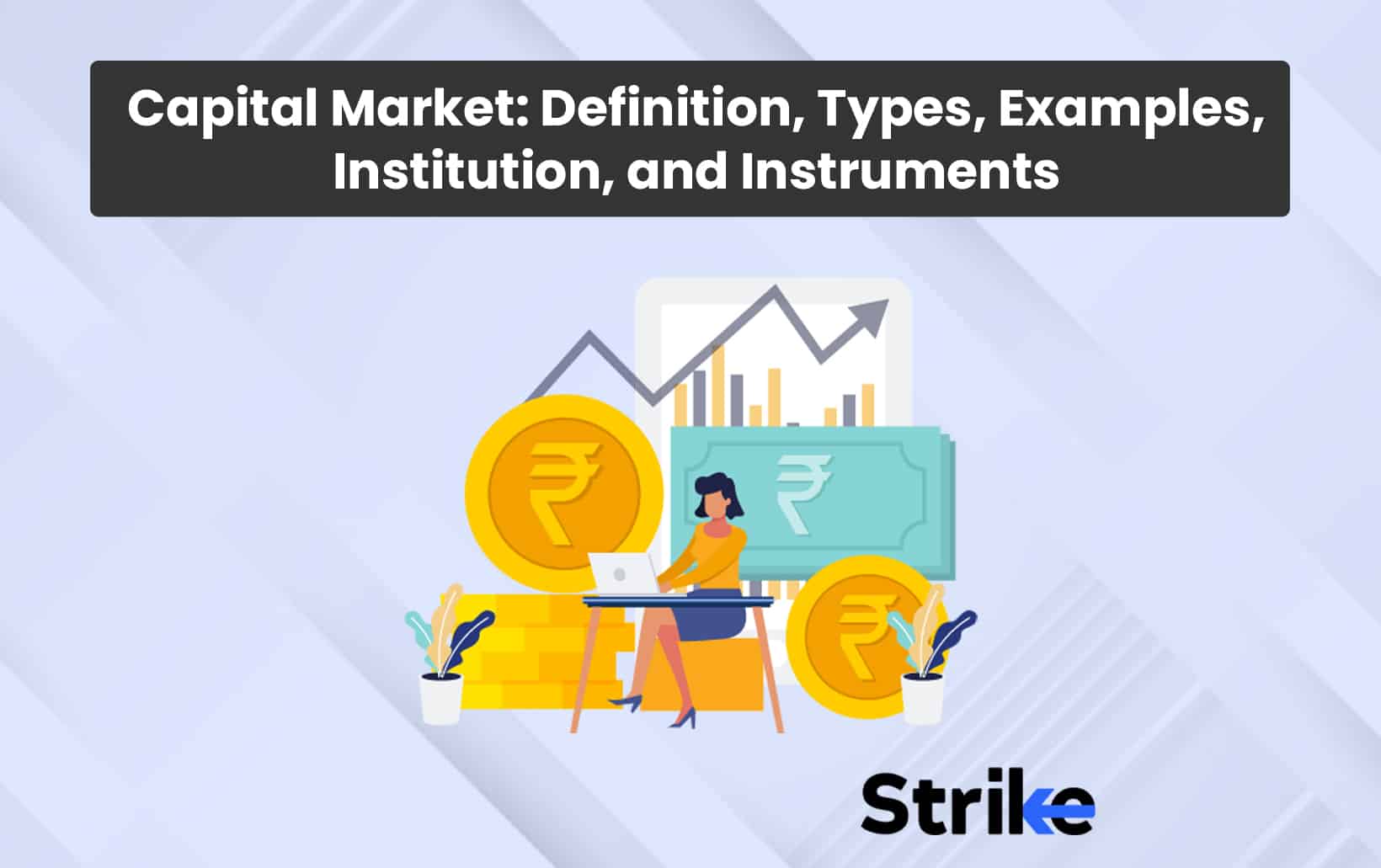
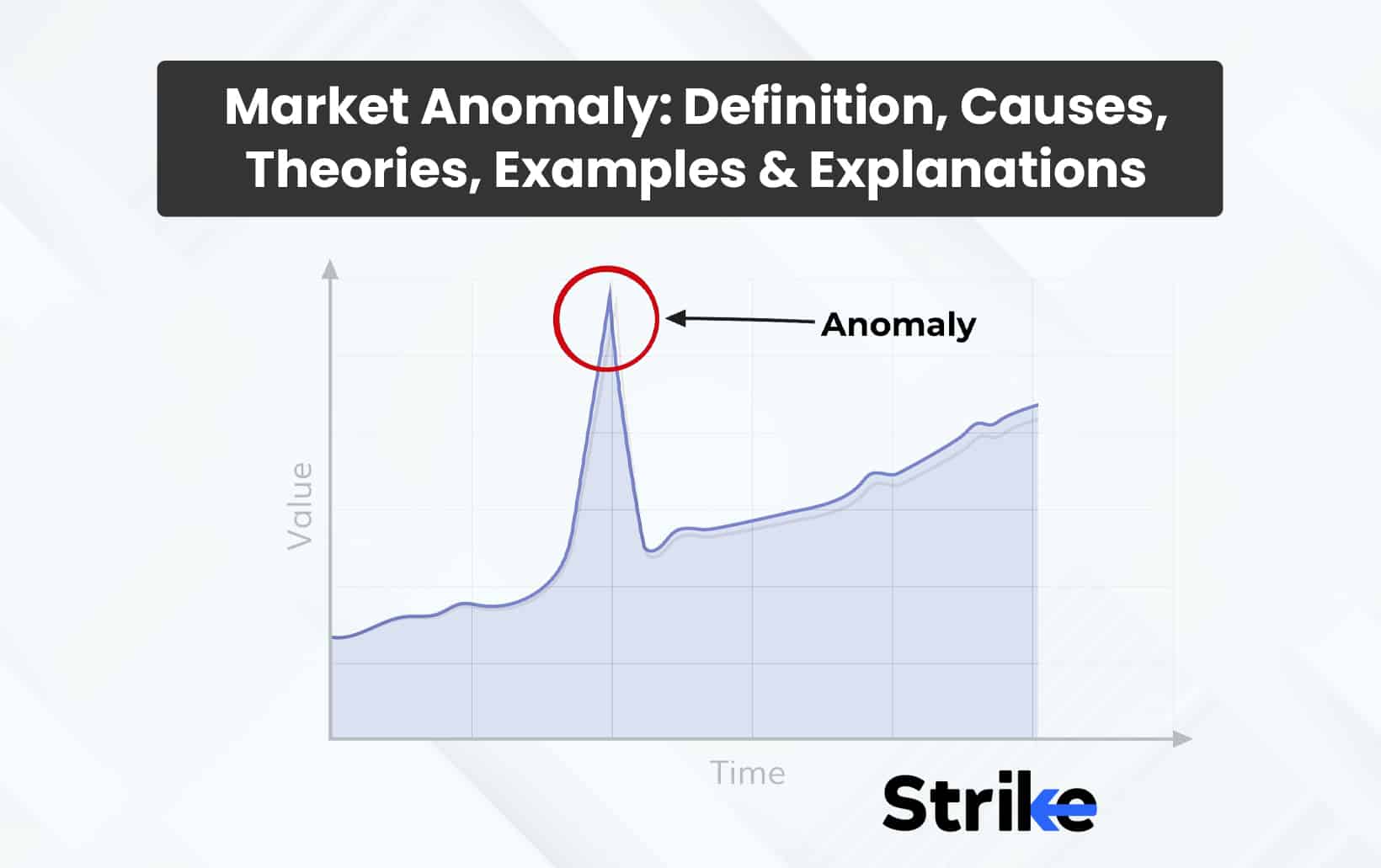

No Comments Yet